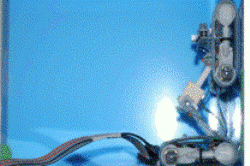Scientists from the Institute of Physics have developed a tank-robot, which is capable of climbing smooth walls. This wall scaling ability of the robot can make it useful in a variety of applications such as pipe inspection, aircraft and nuclear plant inspection as well.
 Tank-Robot
Tank-Robot
The research findings were published in the 1 November edition of their journal, Smart Materials and Structures. The design of the robot was inspired by the gecko lizard. In the past, suction cups, magnets, claws and spine have been used to in wall-climbing robots but these were not successful for climbing smooth surfaces such as plastic or glass. The researchers have tried to mimic the sticky, dry toe pads of the lizard by using adhesives to enable the robot to scale walls and also move across ceilings.
Tank robots that are moved with the help of belts exhibit better control in movement when compared to those that use their legs. Belt-driven robots can be extended similar to a train, in case one needs to increase the load carried by the robot. The robot is called Timeless Belt Climbing Platform (TBCP-II) and is capable of transferring its weight from a flat surface to a wall both at the inner and outer corners at a speed of 3.4 cm/s.
Scientists reach the heights with gecko-inspired robot
The robot is equipped with a number of sensors for detecting the surrounding surfaces and move without colliding with objects. The lead researcher, Jeff Krahn, said that the robot has the capability of working quite independently when it encounters large objects like walls or boxes. He also stated that they are still working on a control strategy to make sure the robot can function with complete autonomy. He added that they have used polydimethylsiloxane (PDMS) to build the toe pads of the robot so that it is able to create van der Waals force with the surface, similar to how the gecko lizard does for executing movement. The dry, sticky toe pads of the lizard are also termed as dry fibrillar adhesives and when recreated for the robot as tiny mushroom caps were of size 17µm wide and 10 µm high.